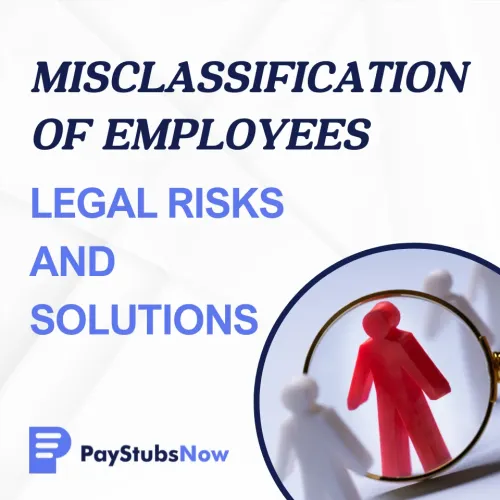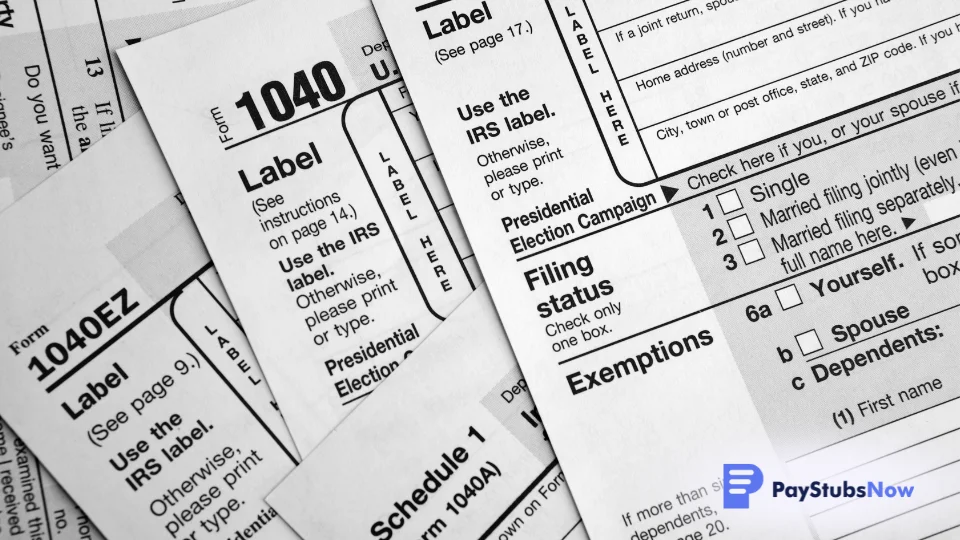


For modern businesses, accurately classifying employees is a critical element of legal compliance and operational integrity. The distinction between an employee and an independent contractor may seem straightforward on the surface, but the stakes of misclassification are incredibly high.
If employees are misclassified as independent contractors, or vice versa, it can expose businesses to major legal and financial risks, especially penalties from the Internal Revenue Service (IRS).
In this article, we will explore employee misclassification in detail, discussing the differences between employees and independent contractors, the legal tests used to determine proper classification, and the potential consequences of misclassification. We will then offer practical tactics to avoid misclassifying employees and highlight how Paystubsnow can help you stay compliant.
Employee misclassification happens when an employer inaccurately categorizes a worker as an independent contractor instead of an employee or the other way around. This can happen for several reasons—sometimes unintentionally due to misunderstandings of labor laws and other times due to willful ignorance. Regardless of intent, the consequences of misclassification can be profound for both the business and the misclassified worker(s).

While both types of workers contribute to an organization's success, the lines can sometimes blur since they are governed by different legal standards, obligations, and protections.
Employees work under the direction and control of an employer. The employer typically dictates the hours, location, and methods of work. Employees are integrated into the organization's structure and are often provided with benefits such as health insurance, retirement plans, and paid time off.
Employers are responsible for withholding and paying state and federal income taxes, including Social Security and Medicare taxes, and for providing workers' compensation coverage.
Independent contractors, on the other hand, are self-employed individuals who provide services to clients. They typically have control over how and when they perform their work and are not subject to the same level of supervision as employees.
Independent contractors are responsible for paying their own self-employment taxes and are not entitled to the same benefits and protections as employees, such as unemployment insurance or worker's compensation. They usually use their own tools and materials.

Correctly classifying your workers is not just a matter of semantics; it carries significant implications pertaining to the following:
Accurate classification determines who is responsible for paying employment taxes. Employers are required to withhold and pay income taxes for employees, while independent contractors are responsible for paying their own self-employment taxes .
When a worker is misclassified, the business may inadvertently evade payroll taxes associated with employee compensation, potentially incurring penalties and back taxes from the IRS.
Under federal and state laws, employees are entitled to a range of benefits and protections, including minimum wage and overtime pay, workers' compensation, unemployment insurance, and protection against discrimination.
Independent contractors, however, do not receive these benefits, which can create significant inequities for misclassified workers.
Misclassifying an employee as an independent contractor can deprive them of essential rights and remedies under labor laws, such as protection against unfair dismissal or the right to file for unemployment benefits, and expose employers to lawsuits and reputational damage.
Therefore, proper classification is necessary to ensure that each eligible worker is afforded these legal rights and protections.
Businesses must apply established legal tests to determine whether a worker is an employee or an independent contractor. These tests consider various factors to assess the nature of the working relationship.
The IRS uses the common law test to determine worker classification. This test focuses on the degree of control and independence in the working relationship. It considers three main criteria:
The DOL uses the economic reality test to determine whether a worker is an employee under the Fair Labor Standards Act (FLSA). This test focuses on whether the worker is economically dependent on the business or is in business for themselves, considering factors such as:
Some states, mainly California, apply the ABC test to determine worker classification. This test presumes that a worker is an employee unless the business can prove all three of the following:

Misclassifying employees can expose businesses to a number of legal and financial risks, such as:
When businesses misclassify employees , they may inadvertently evade payroll taxes, exposing themselves to significant IRS penalties. The Internal Revenue Service can impose fines for unpaid taxes, which not only include back wages but also interest on those amounts.
Misclassification can also lead to violations related to minimum wage and overtime pay, putting businesses at risk of legal repercussions.
If a worker is incorrectly classified as an independent contractor, they may miss out on entitlement to minimum wage and overtime compensation. Consequently, employers could face lawsuits, which can result in costly settlements and legal fees that can impact overall profitability.
Businesses can become targets for lawsuits and class actions initiated by misclassified workers. These legal actions may seek unpaid wages, damages for lost benefits, and the recovery of attorney fees.
By filing a class action lawsuit, multiple employees can band together and file a case against the employer, which can increase the financial consequences against the company and hurt their reputation in the industry.
Misclassification issues can trigger investigations by state and federal agencies, further escalating the risks for businesses.
Agencies like the Department of Labor may conduct audits to assess compliance with labor laws, and findings of misclassification can lead to heavy fines and penalties. Such investigations incur immediate financial liabilities and also result in long-term consequences, including increased scrutiny and a damaged public image.

Misclassifying employees can lead to significant legal and financial risks, but businesses can stay compliant by following these key strategies:
Labor laws can vary from one state to another, making it vital for employers to stay informed about local regulations in addition to federal laws.
Regularly review updates and changes to state legislation to remain compliant. By understanding the specific classification criteria that apply in your state, you can better ensure that your workforce is classified correctly, minimizing your exposure to legal risks.
Establishing a routine for reviewing the classification of workers in your organization can help your business quickly identify any potential misclassifications before they escalate into larger issues.
This proactive approach encourages adherence to legal standards and helps maintain a fair and equitable workplace. Create a checklist of criteria based on applicable laws and use a consistent framework for evaluations.
When classifying workers, it’s crucial to consistently apply the IRS, DOL, and relevant state classification tests. Familiarize yourself with these assessment criteria and be diligent in evaluating each worker against these benchmarks.
Maintaining documentation of the classification process can provide a clear rationale should questions arise in the future. Regular training for hiring managers and HR personnel on these tests can further ensure that classifications are made accurately and responsibly.
When navigating the complexities of labor classification laws, it’s beneficial to consult with legal and human resources professionals who specialize in this area. Their expertise can provide clarity on intricate issues and offer guidance tailored to your organization’s specific circumstances.
Engage in regular consultations to stay abreast of any legal changes and adapt promptly to reduce the risks of misclassification.
Proper worker classification starts with accurate payroll records and clear documentation. Using tools like Paystubsnow ensures that independent contractors and employees receive properly categorized pay stubs, helping businesses maintain transparency and compliance. Paystubsnow provides a streamlined way to generate detailed pay records, making it easier to track worker status, earnings, and tax withholdings—key factors in proving correct classification.
By automating payroll documentation, businesses reduce clerical errors and create a clear audit trail in case of classification disputes. Investing in the right tools not only simplifies record-keeping but also protects businesses from compliance risks, fines, and potential legal challenges.
Employee misclassification is a serious issue that can impact businesses in several ways. Understanding the differences between employees and independent contractors, knowing the applicable legal tests, and following detailed documentation practices are all crucial elements in maintaining compliance.
Using tools like Paystubsnow streamlines the payroll documentation process and helps in accurately tracking employee classifications. By maintaining up-to-date and accurate records, your business can provide proof of compliance should any questions arise from agencies or audits. This safeguards against misclassification penalties and also fortifies the reputation of your business in the market.